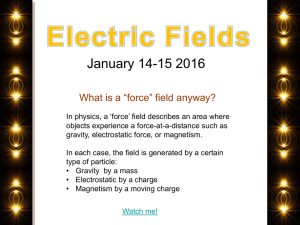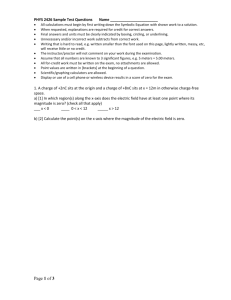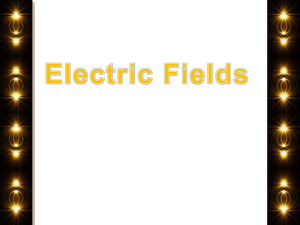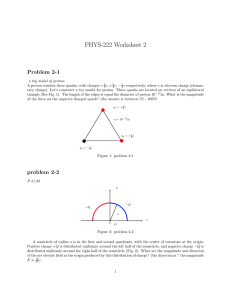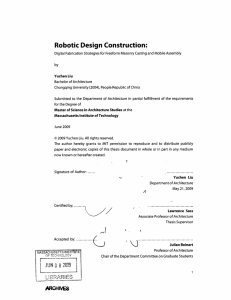Dr. Snake's “Electrostatic Express”
advertisement
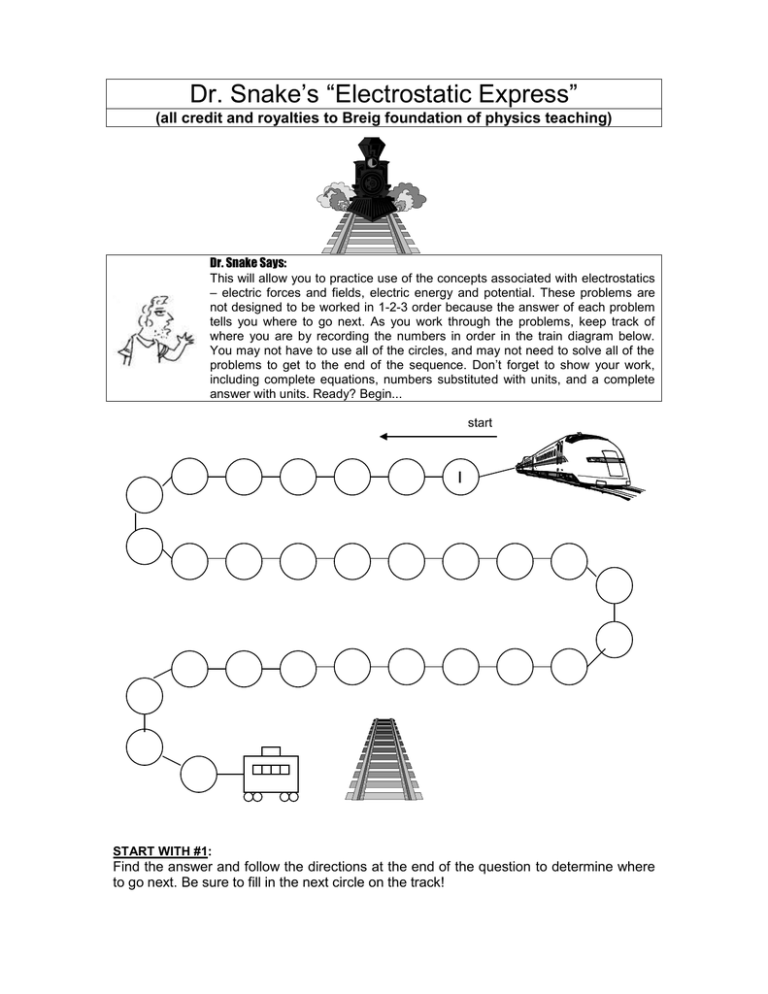
Dr. Snake’s “Electrostatic Express” (all credit and royalties to Breig foundation of physics teaching) Dr. Snake Says: This will allow you to practice use of the concepts associated with electrostatics – electric forces and fields, electric energy and potential. These problems are not designed to be worked in 1-2-3 order because the answer of each problem tells you where to go next. As you work through the problems, keep track of where you are by recording the numbers in order in the train diagram below. You may not have to use all of the circles, and may not need to solve all of the problems to get to the end of the sequence. Don’t forget to show your work, including complete equations, numbers substituted with units, and a complete answer with units. Ready? Begin... start START WITH #1: Find the answer and follow the directions at the end of the question to determine where to go next. Be sure to fill in the next circle on the track! 1. Welcome to Electrostatic Express. How many electrons must be removed from an electrically neutral silver dollar to give it a charge of +2.4 C? Put your answer into scientific notation and look at the second digit; go to that number next. # electrons= 2.4 x10- 6 C * 1 electron/ 1.6 x 10-19 C = 1.5 x 10 13 electons 2. Welcome from #16. Two point charges, +3.40 C and -6.10 C, are separated by 1.20 m. What is the electric potential midway between them? Multiply the ten thousands digit by 2.5 and go there next. 3. Welcome from #14. There are four charges, each with a magnitude of 2.0 C. Two are positive and two are negative. The charges are fixed to the corners of a 0.30 m square, one to a corner, in such a way that the net force on any charge is directed toward the center of the square. Find the magnitude of the net electrostatic force experienced by any charge. Divide your answer by .06 and go there next. 4. Welcome from #13. A uniform electric field has a magnitude of 2.3 x103 N/C. In a vacuum, a proton begins with a speed of 2.5 x104 m/s and moves in the direction of the field. Find the speed of the proton after it has moved a distance of 2.0 mm. Go to the thousands digit next. 5. Welcome from #1. The drawing shows three point charges fixed in place. The charge at the coordinate origin has a value of q1 = +8.00 C; the other two have identical magnitudes, but opposite signs: q2 = -5.00 C and q3 = +5.00 C. q1 1.30 m 23O 23O 1.30 m q2 q3 If q1 had a mass of 1.50 g and it were free to move, what would be its acceleration? Write your answer in Scientific notation and multiply the power by 7; go there next. Find the forces using 1.30 m as the distance, than find Fnet in both the x and y direction: F12 = kq1q2/r2 = 9e9 * 8e-6 * -5e-6 / (1.30)2= - 0.213 (pulls up and east) F13 = kq1q3/r2 = 9e9 * 8e-6 * +5e-6 / (1.30)2=+.213 (pushes up and west) by symmetry west and east cancel so only need y forces which add up Fnet = 2* Fy = 2 * 0 .213 sin(23) =.166 A= Fnet/m = .166 N/ .0015kg = 111 m/s2 or 1.11 x 102 ≫≫≫>go to 7 * 2 = problem #14 6. Welcome from #3.. An electric field of 260,000 N/C points due west at a certain spot. What are is the magnitude of the force that acts on a charge of -7.0 C at this spot? Take the tenths digit and subtract one; go there next. 7. Welcome from #6 . A tiny ball (mass = 0.012 kg) carries a charge of -18 C. What electric field magnitude is needed to cause the ball to float above the ground? Divide your answer by 500 and go there next. 8. Welcome from #4. The drawing shows an electron entering the lower left side of a parallel plate capacitor and exiting at the upper right side. 2.00 cm 0.150 cm The initial speed of the electron is 7.00 x106 m/s. The capacitor is 2.00 cm long and the plates are separated by 0.150 cm. Assume that the electric field is uniform everywhere and find its magnitude. Take the cube root of your answer and truncate the remainder; go there next. 9. Welcome from #12. There is an electric potential of +130 V at a spot that is 0.25 m away from a charge. Find the magnitude of the charge. Write in scientific notation and divide the power by .6; go there next. 10. Congratulations!. You have now completed the Electrostatic Express! 11. Welcome from #15. Two identical point charges are fixed to diagonally opposite corners of a square that is 0.500 m on a side. Each charge is +3.0 x10 -6 C. How much work is done by the electric force as one of the charges moves to an empty corner? Square the hundredths place digit and go there. 12. Welcome from #8. A small plastic ball of mass 6.50 x10-3 kg and charge +0.150 C is suspended from an insulating thread and hangs between the plates of a capacitor (see the drawing below). The ball is in equilibrium, with the thread making an angle of 30.0o with respect to the vertical. The area of each plate is 0.0150 m2. What is the magnitude of the charge on each plate? Write in scientific notation, square the ones digit, and go there next. 13. Welcome from #7. A proton is moving parallel to a uniform electric field. The electric field accelerates the proton and increases its linear momentum to 5.0 x10-23 kg m/s in a time of 6.3 x10-6 s. What is the magnitude of the electric field? Go to the problem whose number is your answer’s ones digit. 14. Welcome from #5. A small spherical insulator of mass 8.00 x10-2 kg and charge of +0.600 C is hung by a thin wire of negligible mass. A charge of -0.900 C is held 0.150 m from the sphere and directly to the right of it, so the wire makes an angle with it. 0.150 m +0.6 C -0.9 C Find the angle. Divide your answer (in degrees) by 5 and go there. Draw a free body diagram to relate tension, weight, and electric force Ty = Wt = mg = 8.00 x10-2 kg x 9.8= Tx = Fe = kq1q2/r2 = 9e9 * .6e-6 * -.9e-6 / (.15)2 = tan (0) = Tx/Ty 15. Welcome from #9. An electron and a proton are initially very far apart (effectively an infinite distance apart). They are then brought together to form a hydrogen atom, in which the electron orbits the proton at an average distance of 5.29 x10-11 m. What is the change in the electric potential energy? Write in scientific notation, take the absolute value of the power, divide by 7, and go there next. 16. Welcome from #11. A charge of -3.00 C is fixed in place. From a horizontal distance of 0.0450 m, a particle of mass 7.20 x10-3 kg and charge -8.00 C is fired with an initial speed of 65.0 m/s directly toward the fixed charge. How far does the particle travel before its speed is zero? Write in scientific notation, take the absolute value of the power, and go there next.




